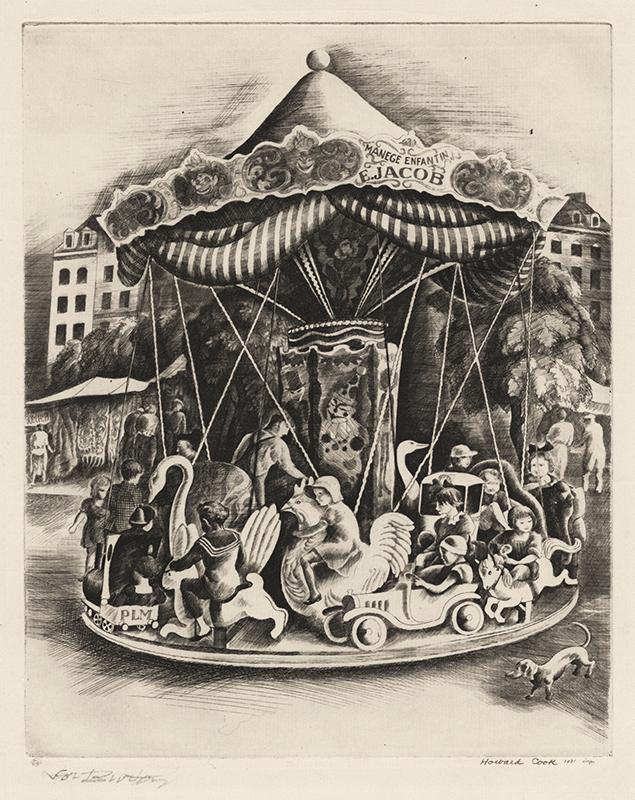
19th, 20th & 21st Century Fine Prints
707-546-7352 · fax 707-546-7924 · web: www.annexgalleries.com · email: artannex@aol.com
Merry Go Round by Howard Norton Cook



Merry Go Round
Howard Norton Cook
Merry Go Round
Howard Norton Cook
1901 - 1980 (biography)The original mat with this impression had the pencil notations: "Merry Go-Round - Bastille Day / Paris 1931 / Montparnasse - / etching printed by Howard Cook / Last of edition (50).
This 'Manège Enfants' (merry go round) was part of the Bastille Day celebration in Montparnasse. A related drawing is in the Smithsonian American Art Museum (object 1980.18.1). There are around 20 carousels in Paris that often located near tourist attractions. The 1900s are consided the Golden Age for the manège.
This image is included as plate 24 in Thomas Craven's "A Treasury of American Prints" and, despite the word "repro" in the lower left margin, can be found on-line being sold as an original.
Howard Norton Cook was born in Springfield, Massachusetts, in 1901. His artistic endeavors began in 1920 at the Art Students league in New York on a $500 scholarship; in 1922 he traveled throughout Europe, sketching and writing for a few travel publications in the U.S. When he returned, it was to study under Joseph Pennell at the league. Pennell would introduce him to printmaking, which would become one of Cook's main mediums throughout his career. An adventurous spirit, Cook would continue to travel, whether through employment on ships or on his own, and would illustrate his journeys in prints and drawings.
Cook traveled to Santa Fe in 1926 after a commission sent him to New Mexico to do illustrations of the region. Within the year, he had moved to Taos, quickly becoming a part of the still-small artists' community. Here he met and married artist Barbara Latham, printmaker and painter, and together built careers doing fine art. Cook began to exhibit in, starting Colorado in 1927, and then in 1928 returned to New York to try to get a foot in the door of the bustling artistic metropolis. He met and established a lifelong friendship with Carl Zigrosser, at the time the director of the Weyhe Gallery and a foremost authority on prints. Zigrosser became Cook's benefactor, and soon Cook was exhibiting in Manhattan. In 1931 he received the first of two Guggenheim fellowships and went to Mexico, where he discovered frescoes, a medium he would soon employ and become known for.
A rising reputation as a correspondence illustrator and printmaker led to a commission by the Office of War Information to record the American involvement in the South Pacific. He created numerous paintings, pastels, and prints of his time there, which would be compiled for a show in Washington D.C. and New York. In 1949, he was elected Academician of the National Academy of Design for his life work, and he continued to exhibit throughout the 1950s and 1960s. Diagnosed with multiple sclerosis in 1963 after years of health problems, Cook was confined to a wheelchair in his last decade. He died in 1980.



